The Qualcomm Snapdragon 820 Performance Preview: Meet Kryo
by Ryan Smith & Andrei Frumusanu on December 10, 2015 11:00 AM EST- Posted in
- SoCs
- Snapdragon
- Qualcomm
- Snapdragon 820
GPU Performance
Shifting gears, let’s take a look at GPU performance. As we mentioned earlier, Qualcomm isn’t disclosing much about this GPU other than that it packs quite a bit more computational power than its predecessor and should be quite a bit faster in the process. This points to a potentially significant architectural shift, but that determination will have to wait for another time.
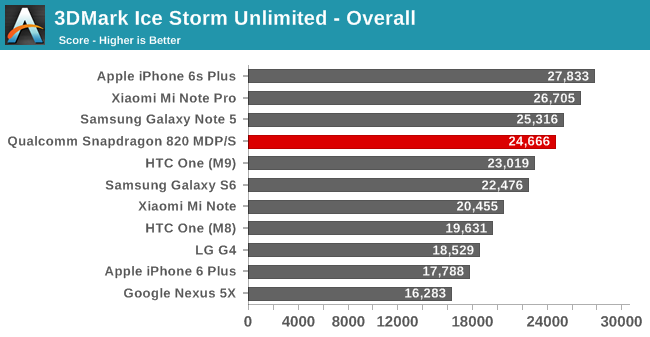
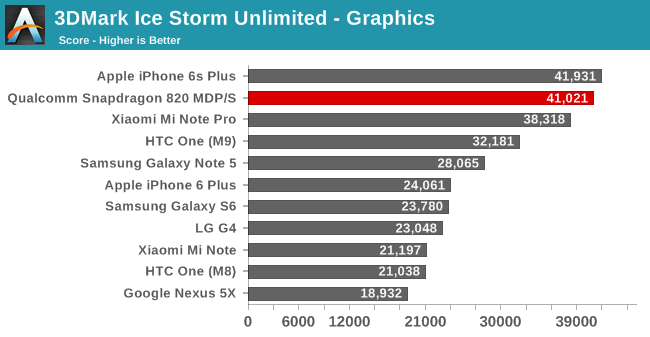
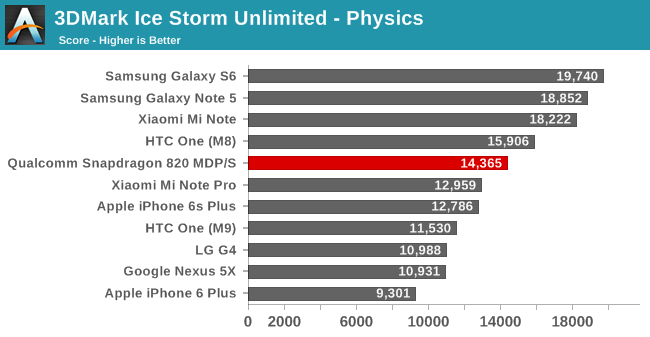
Starting with 3DMark Ice Storm Unlimited, the performance honestly doesn’t start out great. The overall score is significantly influenced by the physics score, which in turn is more concerned with the number of cores and their throughput on simple code than the ability to extract complex IPC. As a result the 4 CPU core 820 simply can’t catch up with the likes of the Samsung devices and their high-clocked big.LITTLE configurations. On the other hand the graphics score makes this the fastest Android phone to date, though relative to the 810 Mi Note Pro, perhaps not by a ton. Ultimately as this is an OpenGL ES 2.x test it’s not the most strenuous of tests these days, and comments from Qualcomm indicate that it may be a CPU-limited test on 820.
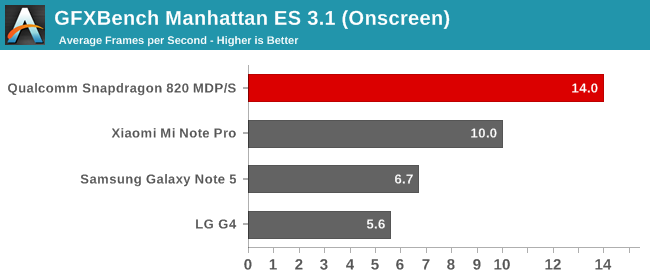
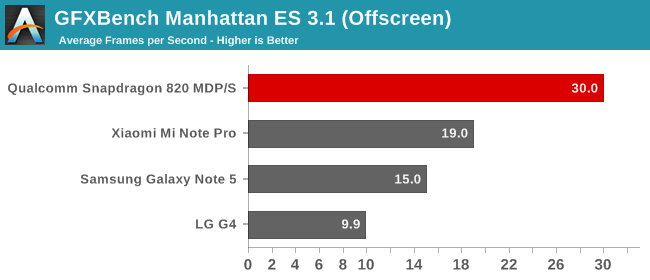
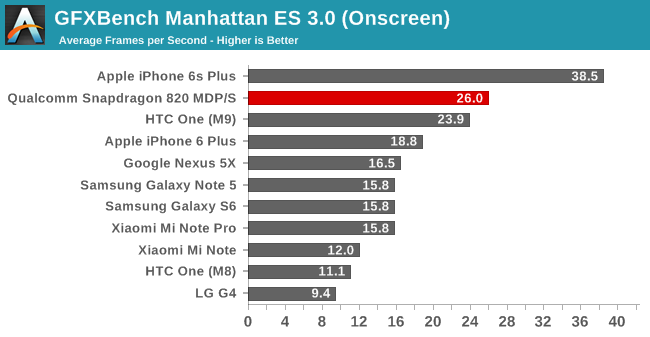
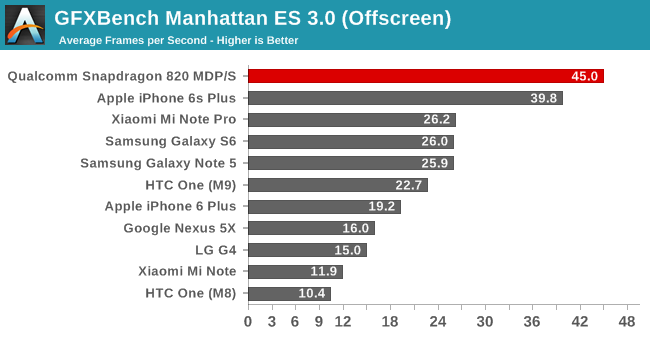
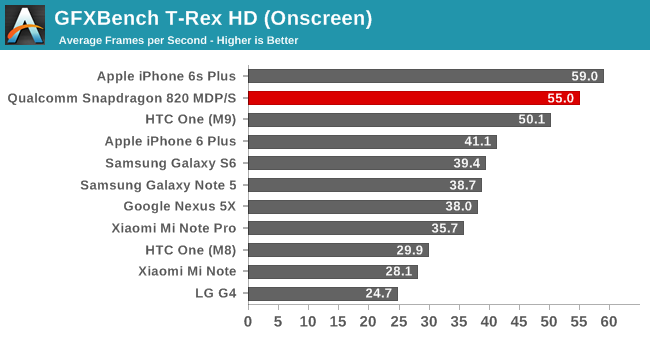
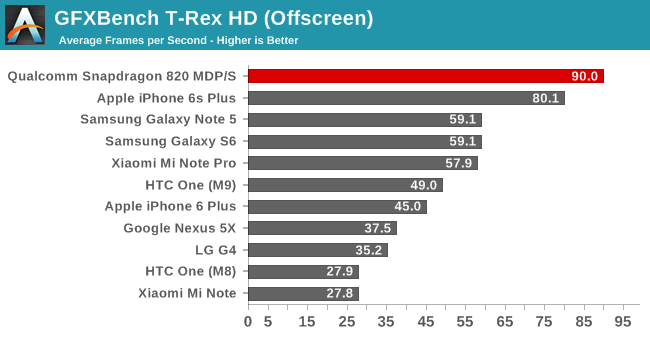
GFXBench on the other hand shows some massive gains for the 820 relative to any other Android device. In offscreen rendering mode, all 3 game tests – Manhattan ES 3.1, Manhattan ES 3.0, and T-Rex HD – put the 820 MDP/S as being 52% (or more) faster than the next-fastest Android device, either the 810 based Mi Note Pro or the Exynos 7420 based Samsung Galaxy Note 5. The single biggest jump we see is with Manhattan ES 3.0 at 72%, while the ES 3.1 version dials that back down to 52%. Even the iPhone 6s Plus, well known for its powerful GPU, is handily and consistently surpassed by the 820 here. Only due to the 6s Plus’s lower rendering resolution of 2208x1242 does it surpass the MDP/S in onscreen tests, as the latter needs to render at 2560x1600 (~50% more pixels). Qualcomm was aiming for some big GPU performance gains here and so far they are delivering.

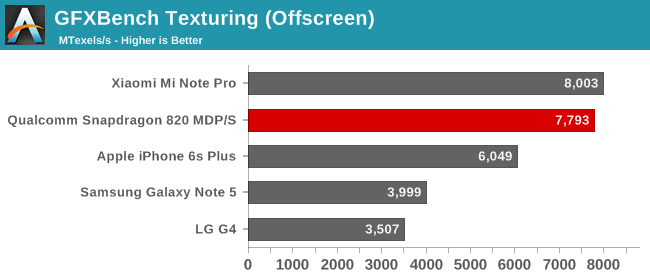
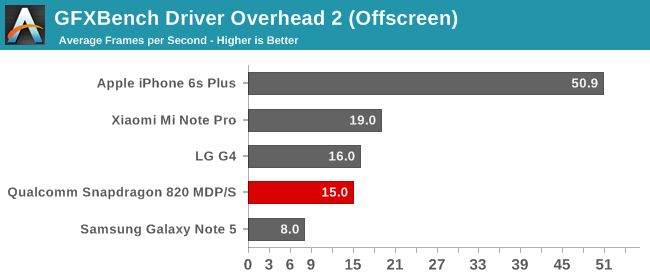
Curiously, GFXBench’s synthetic feature tests don’t show the same gains. Offscreen ALU performance is only slightly improved over the 810 (10%) or in the case of texturing is an outright regression. None-the-less full gaming performance is clearly in the 820’s favor. I’ve long suspected that the Adreno 430 GPU in the 810 had some kind of architectural bottleneck – perhaps an ALU/texture array that was difficult to fully utilize – and what we’re seeing here would back up that claim, as if that was the case then correcting it would have allowed Qualcomm to significantly boost their rendering performance while only barely changing their synthetic performance. Otherwise I find it a bit surprising that the driver overhead score is a bit worse on 820 than 810, which may be a result of the immature GPU drivers on this early device.










146 Comments
View All Comments
BurntMyBacon - Monday, December 14, 2015 - link
@mmrezaie: "It is actually at best as good as A72 performances reported so far, and not even on a same node size. So what was all the reason behind research and development when you build something as good as ARM's offering."To be fair, Qualcomm used ARM cores for the 810 and that turn out, lets say, less than stellar. I can understand why they might want to go back to their own IP. Even if performance is the same, that doesn't mean power consumption, heat density, etc. are the same. Samsung uses ARM cores for their Exynos chips and IIRC they had to fix a problem with their cores in the past as well to get the cores up to the speed they wanted. Also, designing it yourself can be cheaper than buying the core from ARM if you are proficient enough.
melgross - Thursday, December 10, 2015 - link
What happened, really, was that the Exynos chips weren't as good as the Snapdragon, and would be used in areas of the world where cost was more important that ultimate performance. The 810 wasn't used by them because it wasn't a very good chip, and it's only been recently, with the latter tape-outs, that aimed of the heating problems have been mitigated.lilmoe - Friday, December 11, 2015 - link
"Exynos chips weren't as good as the Snapdragon"I'm not sure when this false perception started, but that's just the fantasy of a handful of Snapdragon apologists. Exynos SoCs have ALWAYS been better than Snapdragons since their inception with the Hummingbird (GS1). Samsung has only stumbled with the Exynos 5410 (where they didn't have a "working" CCI), and less so on the 5420, and that was more like ARM's fault rather than Samsung's. Samsung later "fixed" ARM's design and moved forward with better chips than Qualcomm's offerings starting with the Exynos 5422 (except for the integrated modem part, up until recently that is).
They sometimes ran hotter than Snapdragons but Samsung always fixes things up with updates. Apps and Games have always run better and smoother on Exynos variants (even the 5410), and they've always aged better, *especially* after patches and software updates. I can attest to that through experience, and so can many reviewers.
Snapdragon apologists have always argued "custom ROM support". That's a very small percentage of users. Like REALLY small, to the point of irrelevance.
kspirit - Friday, December 11, 2015 - link
The main reason I do prefer devices with snapdragon SoCs is because of AOSP-based ROMs. You're right, it's a very small minority, but it's still nice to have. Samsung makes A+ hardware but their software is kind of meh to me. Personal preference and all.But Exynos hasn't historically been a very good chipset. Sure, it beat the 810 this year and did well with heat, but there have been shortcomings on Exynos in the past.
I remember back in the days of GS2, Exynos didn't have anything on their chipset to support notification LEDs (and even if they did, no one knew how to use them), while the same was available on Qualcomm's chips. Also, up to at least the Galaxy S4 (maybe even S5), Samsung's Exynos devices had a very seriously annoying lag between the time the home button was pressed and the screen turned on. Someone said it was because of the S-voice shortcut but it persisted on custom ROMs where S-Voice wasn't even there. It was some hardware thing.
TL;DR: being a benchmark destroyer isn't everything.
Andrei Frumusanu - Saturday, December 12, 2015 - link
Notification LEDs have absolutely nothing to so with the SoC...alex3run - Saturday, December 12, 2015 - link
Exynos 5410 wasn't really a failure just because its GPU is FAR ahead of Adreno 320 used in SD600. I was just surprised when saw how bad Adreno 320 runs real 3D games.LiverpoolFC5903 - Monday, December 14, 2015 - link
Thats nowhere near true I am afraid. The Powervr sgx 544 mp3 was beaten in almost every metric by the Adreno 320 rev.2. CPU wise the 5410 was better due to the use of higher ipc A15 cores but GPU performance was better in the Snapdragon 600, in real life as well as in most benchmarks.The Adreno 320 revision 2 is still relevant at around 85 Gflops, peforming better than midrangers like the Adreno 405 and Mali T760 MP2. Its almost identical in performance with the Rogue G6200 used in Mediatek's Mt6595 and Mt6795.
alex3run - Monday, December 21, 2015 - link
Sorry but Adreno 320 v2 doesn't exist at all. Stop believing the delusional lies from a chinese blog.As I said I was just surprised how bad Adreno 320 really is. I don't mind benchmarks because it seems like Qualcomm bought most benchmark makers. Only real performance I trust. Only in real games and apps.
tuxRoller - Monday, December 21, 2015 - link
How do you determine that the pvr sgx 544 is FAR ahead of the adreno 320?Anything reproducible?
V900 - Friday, December 11, 2015 - link
Actually Samsung probably wouldn't save any money by using an Exynos SOC.The two divisions are independent of each other, which means that Samsung the SOC vendor charges Samsung the device vendor the same prices they charge everyone else.
I doubt Apple would let them manufacture their CPUs if they weren't seperate divisions and had firewalls between them.